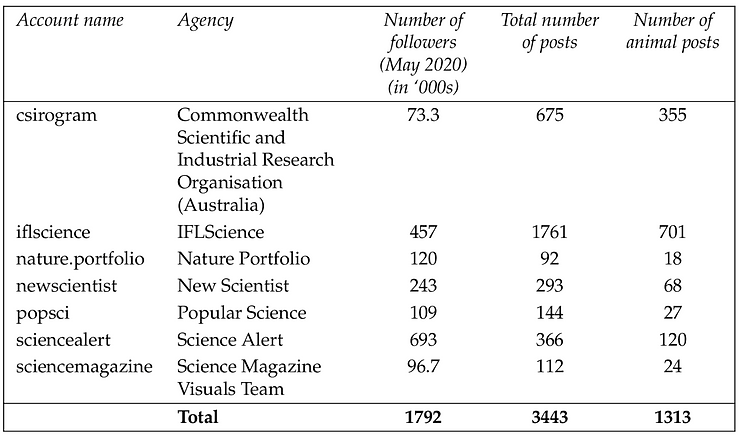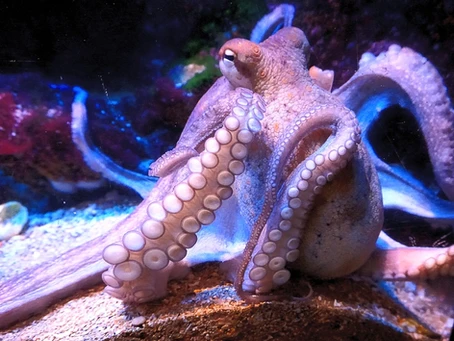The Backbone of Conservation Science Communication: Invertebrates are engaging!
By Kirsten Giesbrecht
Title: Animals of Instagram: taxonomic bias in science communication online
Author(s) and Year: Grace Heathcote, 2021
Journal: Journal of Science Communication
| TL;DR: Although science communication Instagram accounts tend to overrepresent vertebrate animals in their posts, the public often heavily engages with posts of invertebrates like spiders and octopuses. Sharing photos of an invertebrate could even elicit a stronger response in individuals and engage more individuals than a photo of a vertebrate. Due to the public’s influence on conservation efforts, engaging the public with diverse types of animals can be a valuable tool in animal conservation. Why I chose this paper: I was previously aware of the propensity for scientific and conservation communities to focus their attentions on certain types of animals. However, I never thought about how it related to science communication. I was surprised to learn that the public does not necessarily share the same partiality and is more engaged with some invertebrate Instagram posts compared to vertebrate posts examined in this study. |
An octopus, a spider, and a tiger each post a selfie on Instagram – who gets the most attention on their post? According to a recent study, the spider would get the most comments and the octopus would receive the most likes. Tigers would get neither, but they would have the most research funding.
Lions and Tigers and Taxonomic Bias… Oh my!
A recent study by Heathcote examines if the types of animals that receive the most research and conservation funding were the same types that were posted most frequently by an array of popular science communication Instagram accounts. Heathcote then examines which kinds of animals posted by these Instagram accounts receive the most engagement from Instagram users. Her results surprisingly show that the types of animals in the Instagram posts that received the most engagement are often some of the least commonly studied animals.
This phenomenon of focusing conservation efforts, research, or policy recommendations on a subset of animals is called taxonomic bias and typically favors larger terrestrial animals (like elephants or tigers). Taxonomic bias commonly prefers vertebrates – animals with a spinal cord which includes mammals, birds, reptiles, amphibians, and fishes– over invertebrates (such as insects and octopuses), and favors mammals and birds within vertebrates.
Despite invertebrates accounting for over 97% of all animal species, *** Heathcote found that out of all published animal wildlife research, over 80% of the animals studied are vertebrates! Birds and mammals together account for over 60% of all published animal wildlife research. When fewer resources are spent studying invertebrates, existential threats to invertebrates may go undetected since their conservation needs are less understood. This can lead to an incomplete understanding of the health of an environment or the impact that the loss of that understudied species can have on its ecosystem.
Public opinion on wildlife conservation issues can influence scientific research and conservation policies. The public outcry in reaction to a video of a straw being pulled from a sea turtle’s nose led to cities banning plastic straws. Conversely, species that are unknown to the public cannot benefit from the public’s support and influence. Due to the public’s power over conservation and research directions, it is important to communicate a diverse array of animals to them. Social media is growing in popularity as a two-way communication tool for scientists and the public and is a potential outlet to engage the public in diverse animal education and conservation.
The Methods
Due to the power of imagery for conservation efforts paired with Instagram’s popularity and visual nature, Heathcote collected data from Instagram posts from seven popular science communication Instagram accounts (Table 1).

The Instagram accounts in this study were all educational, globally focused, promoted a wide variety of animals, and had a large following. The selection contained both academic and popular news accounts. Any photo and video centering on an animal posted during 2019 from these accounts were analyzed to address two main questions:
Q1. Is taxonomic bias present in the content posted by science communication accounts on Instagram?
Q2. Is taxonomic bias present in the public engagement with these Instagram posts?
When analyzing photo posts, Heathcote measured which types of animals were posted most frequently, received the most likes per post and had the most comments per post. She used the same metrics in analyzing posted videos, except she measured which animal videos had the most views instead of the most likes per post. Heathcote also examined which types of animals elicited the strongest positive and negative emotions in randomly selected posts and comments, by categorizing text and emojis as positive (‘beautiful’, 👏), neutral (requests for more information), or negative (‘yuk!’, 😱 ) responses.
The Results
Of all of these 1313 analyzed Instagram animal posts (961 photos and 352 videos), almost two-thirds of the posts were of vertebrate subjects.
Photo Posts:
Mammals were the most common subject for photos (30%). There were about half as many insect photos posted (16%), while arachnid (such as scorpions and spiders) photos made up just under 4%, and cephalopod (including octopuses and squids) photos accounted for only 2% of posted photos.
Of the animal groups that had at least 11 photos posted, cephalopods had the highest number of likes per photo, with reptiles, mammals, and amphibians garnering the subsequent highest likes per post, respectively. Arachnids, on the other hand, received the highest number of comments per photo post. Amphibians, echinoderms (like starfish and sea urchins), and mammals gained the subsequent highest number of comments per post respectively. Cephalopods elicited some of the strongest positive responses in the comments, while perhaps unsurprisingly, arachnids received the strongest negative responses in the comments.
Video Posts:
Mammals were again the most common video subject posted (29%), but cephalopods and insects subjects accounted for the next highest numbers of videos posted (8%) each. Gastropod (such as snails) videos received the most views with arachnids, fish, and echinoderm videos trailing behind in views, respectively. Just like arachnid photos, arachnid videos had the highest number of comments per video, then gastropods, birds, and mammals with the subsequent highest comments per video.
The Answers
Q1. Is taxonomic bias present in the content posted by science communication accounts on Instagram?
Yes, although there is less taxonomic bias in the selected Instagram content compared to wildlife research trends. While 80% of published wildlife research examines vertebrates, only approximately 60% of the analyzed Instagram posts had vertebrate subjects. This lower taxonomic bias present in Instagram science communication accounts suggests that content creators of these accounts are adapting to the tastes of their audiences, which results in representing more invertebrates.
Q2. Is taxonomic bias present in the public engagement with these Instagram posts?
The public seems more balanced in their engagement with vertebrates and invertebrates. Invertebrates received the most likes per photo, most views per video, and most comments per post in this study. Invertebrates also received some of the strongest positive and negative comments in the analyzed posts.
The Impact
Due to the public’s growing influence on conservation efforts, understanding how to best engage audiences in conservation is critical to stemming the loss of biodiversity globally. This study shows that the public happily engages in posts of invertebrates, possibly due to the unusual appearance of many invertebrates compared to more familiar and frequently posted mammals. Scientist communicators interested in involving the public in conservation efforts should be encouraged to know that the public is interested in both vertebrate and invertebrate content on Instagram. Public opinion plays a critical role in conservation efforts and funding, so exposing the public to a diverse slew of animals can increase the chances of protecting them.
Edited by Kay McCallum and Niveen AbiGhannam
****Editor’s note: As of August 29, 2024, new data from the World Animal Foundation suggests that the initial statistic shared in this article is Outdated. Currently, they estimate that “68.7% of All Animal species are Invertebrates, with a total species population of 1.48 million.“
Cover image credit: awpixel.com (Figures used CC0 1.0 and CC By 4.0)

